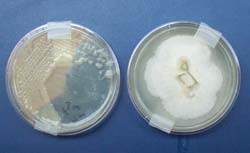Articles and reports from the Life Sciences and chemistry area deal with applied and basic research into modern biology, chemistry and human medicine.
Valuable information can be found on a range of life sciences fields including bacteriology, biochemistry, bionics, bioinformatics, biophysics, biotechnology, genetics, geobotany, human biology, marine biology, microbiology, molecular biology, cellular biology, zoology, bioinorganic chemistry, microchemistry and environmental chemistry.

Research is key step in detoxifying endosulfan toward improving soil and water quality
Scientists at the University of California, Riverside report in the Journal of Environmental Quality (JEQ) that they have isolated microorganisms capable of degrading endosulfan, a chlorinated insecticide widely used all over the world and which is currently registered to control insects and mites on 60 U.S. crops. JEQ, established in 1972, is published jointly by the American Society of Agronomy,

Dartmouth Medical School geneticists studying the biological clock have opened yet another window into the role of an unusual form of RNA known as antisense that blocks the messages of protein-encoding genes.
They found that antisense RNA appears to regulate core timing genes in the circadaian clock that drives the 24-hour light-dark cycle of Neurospora, a model organism better known as bread mold.
The results are reported in the February 27 Nature by Drs. Jennifer Loros and Jay C.

Scientists with the U.S. Department of Energy’s Joint Genome Institute (JGI) and the Lawrence Berkeley National Laboratory (Berkeley Lab) have developed a powerful new technique for deciphering biological information encoded in the human genome. Called “phylogenetic shadowing,” this technique enables scientists to make meaningful comparisons between DNA sequences in the human genome and sequences in the genomes of apes, monkeys, and other non-human primates. With phylogenetic shadowing, scientists c

It is not known what genes turn leaves yellow in the fall. However, scientists at Umeå Plant Science Center, Umeå University, and the Royal Institute of Technology in Stockholm (KTH) have managed to identify more than 2,400 genes that take part in the process.
One of the most magnificent pageants of nature every year is when trees take on their autumn colors. Scientists have long known that these colors appear when the green pigment chlorophyll is broken down at the same time as the yellow c

Of the five basic senses, the sense of smell is the least understood. Now, scientists at the University of Illinois at Urbana-Champaign have sniffed out potential clues to how olfactory receptors in the nose detect odors. Those clues may also explain why dietary zinc deficiencies lead to a loss of smell.
Olfactory receptors are proteins that bridge through the cell membrane. Professor Kenneth S. Suslick and co-workers have found that the structure of the protein changes dramatically when a

A recently discovered enzyme called endothelial lipase regulates the structure, metabolism and blood concentration of high density lipoprotein (HDL), the so-called “good cholesterol,” said researchers from Baylor College of Medicine in a report in the online version of the Proceedings of the National Academy of Sciences.
In a series of studies in mice, Dr. Lawrence Chan, chief of the section of endocrinology and metabolism at Baylor, his co-workers and colleagues from the section of cardiol